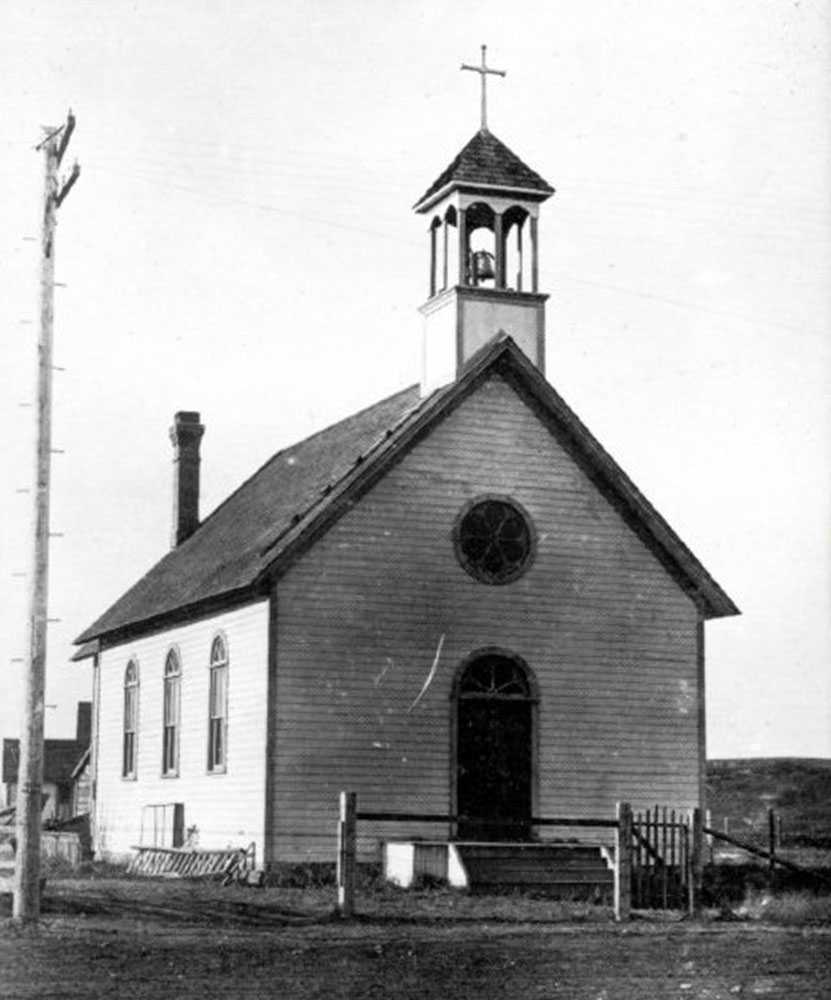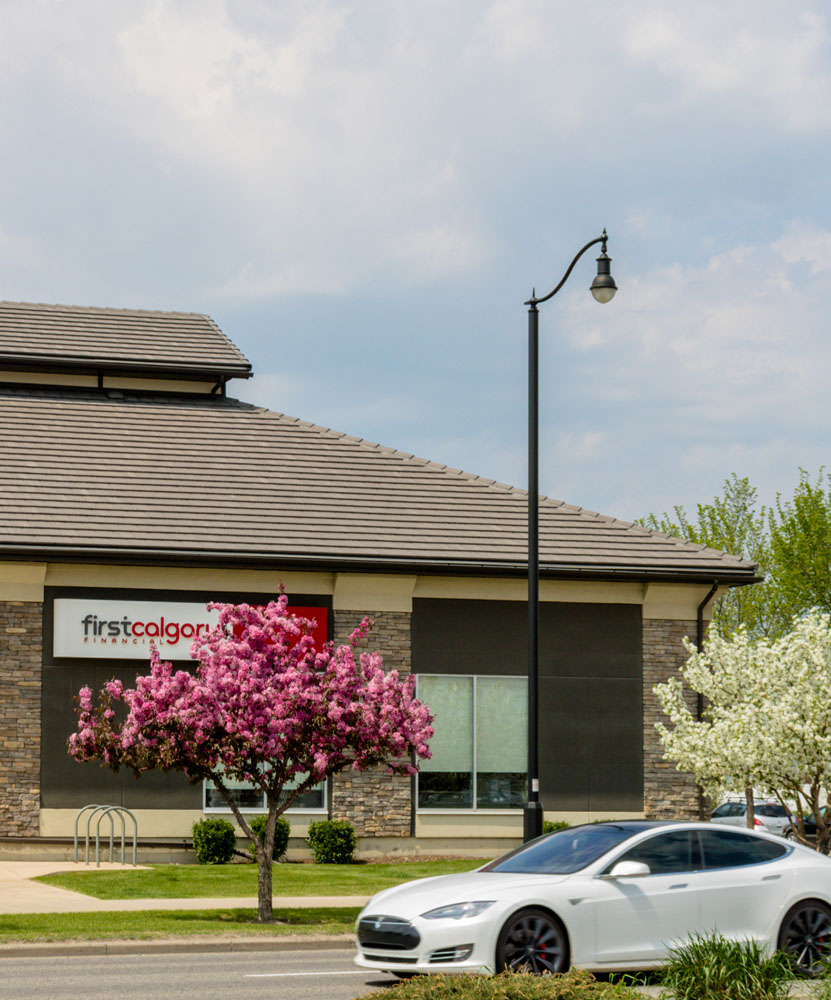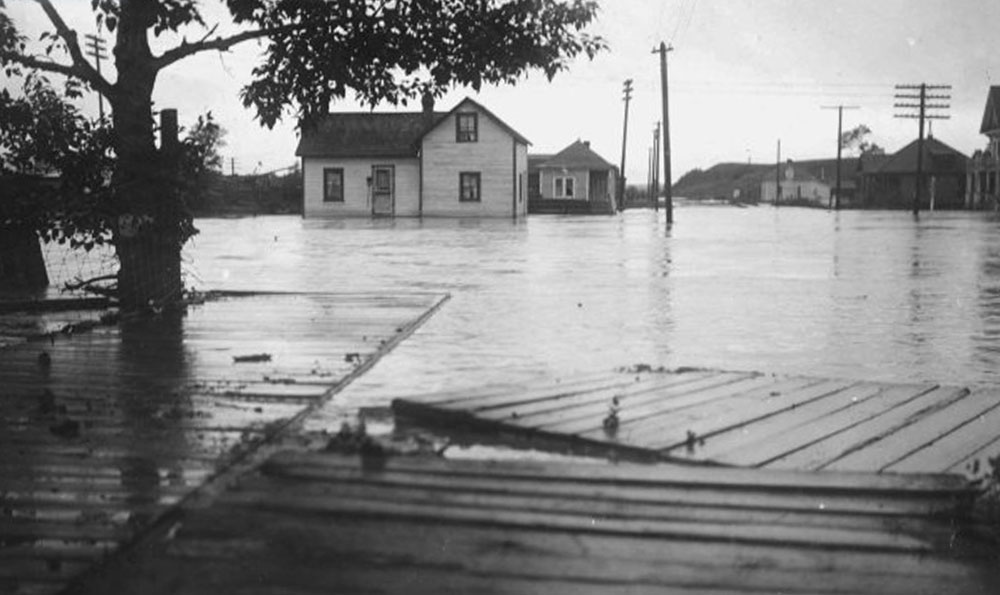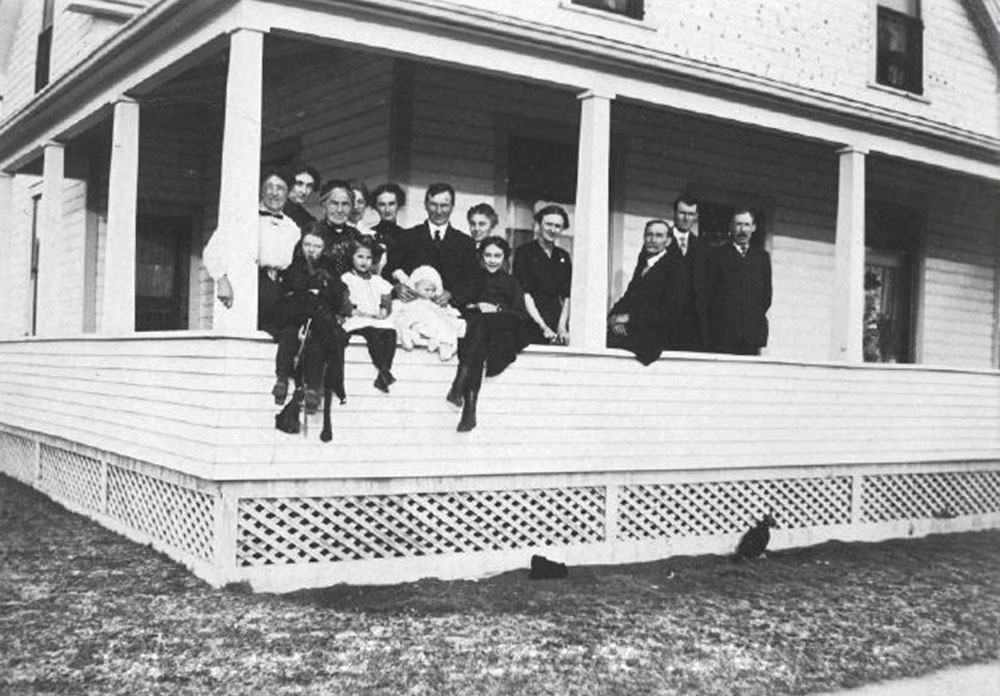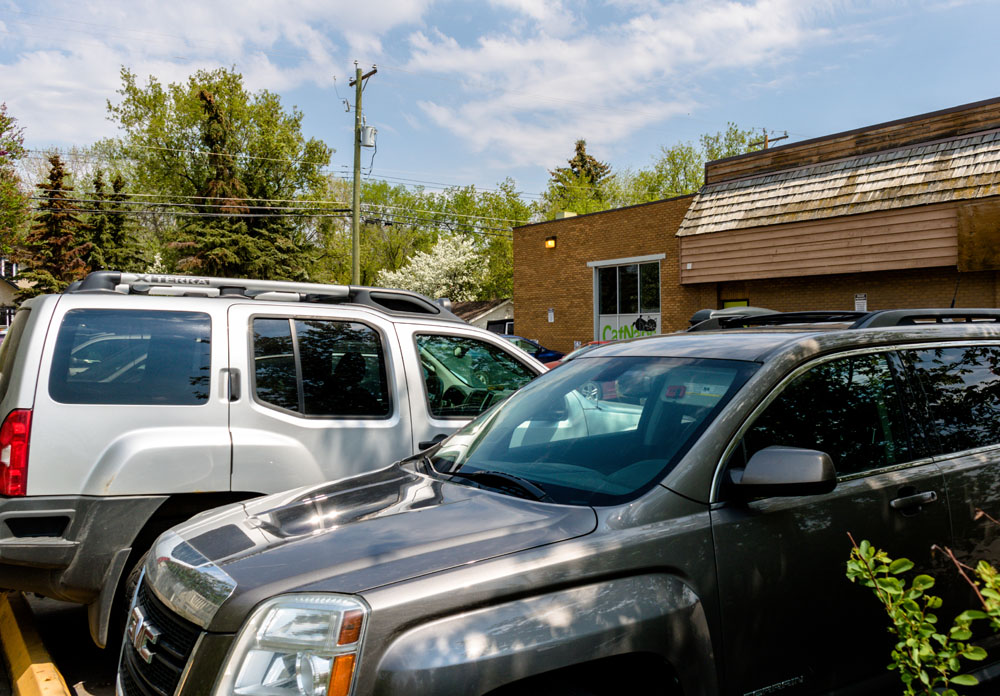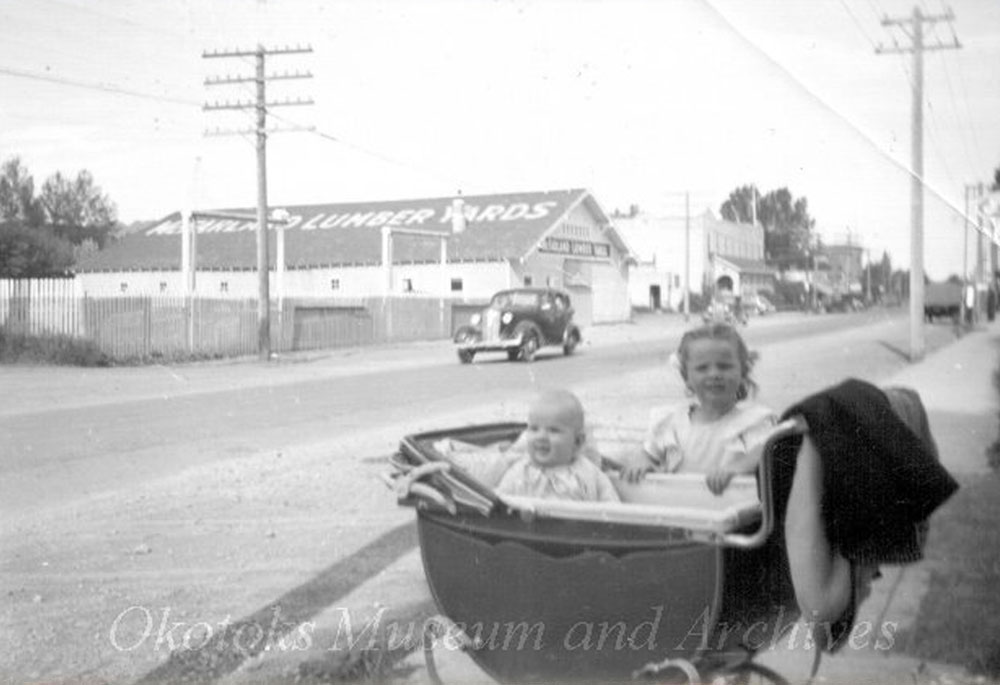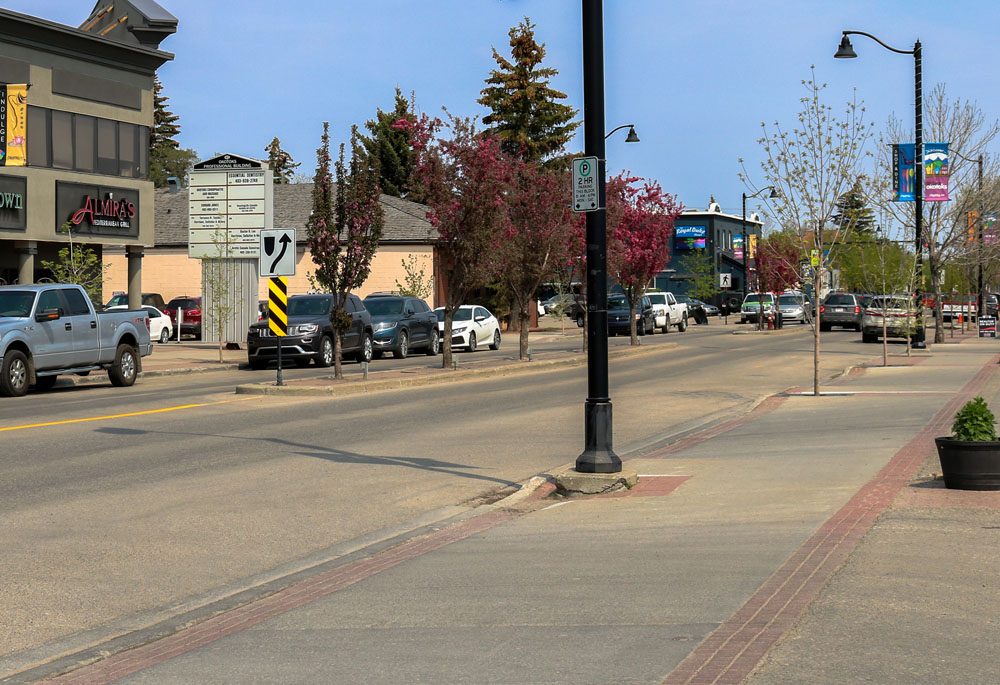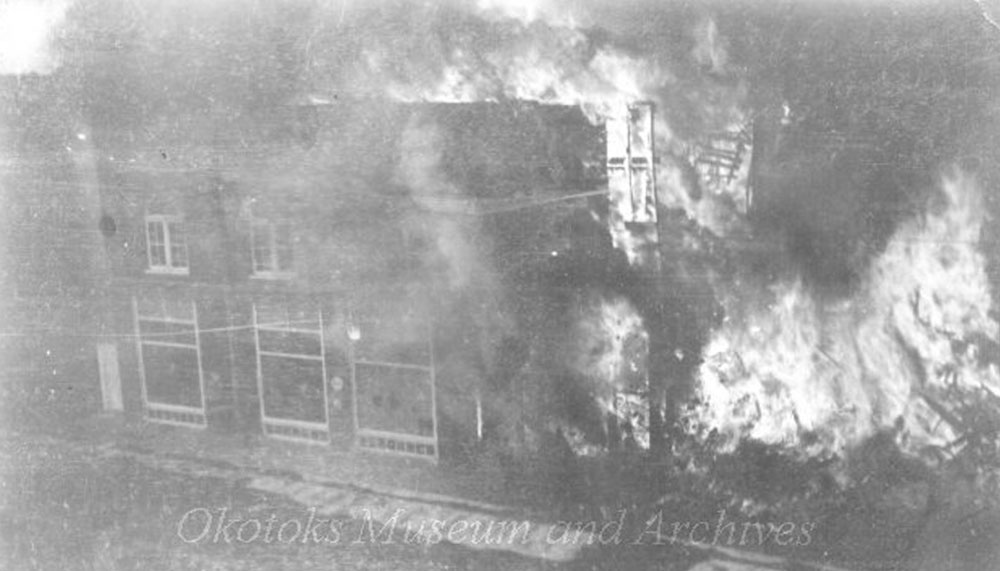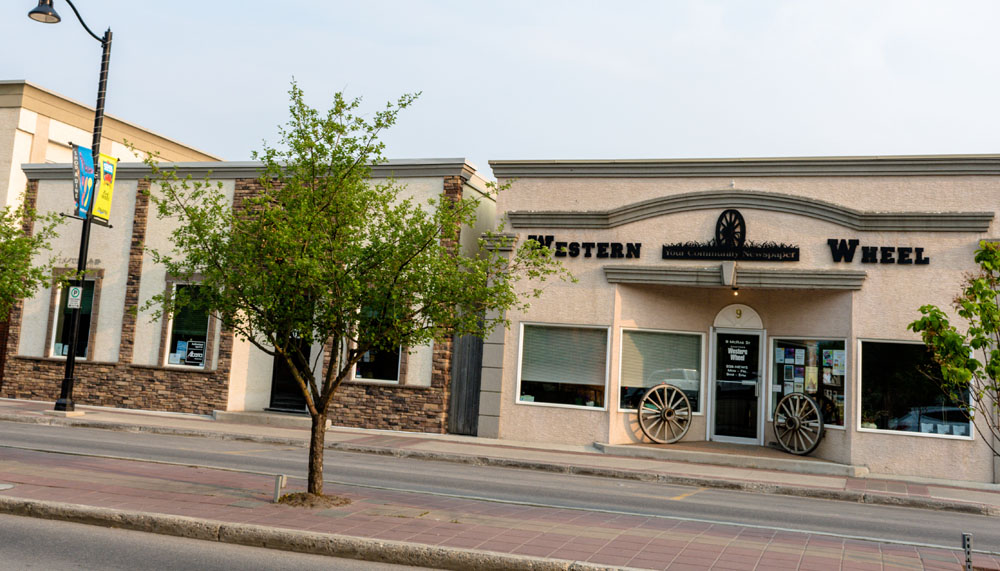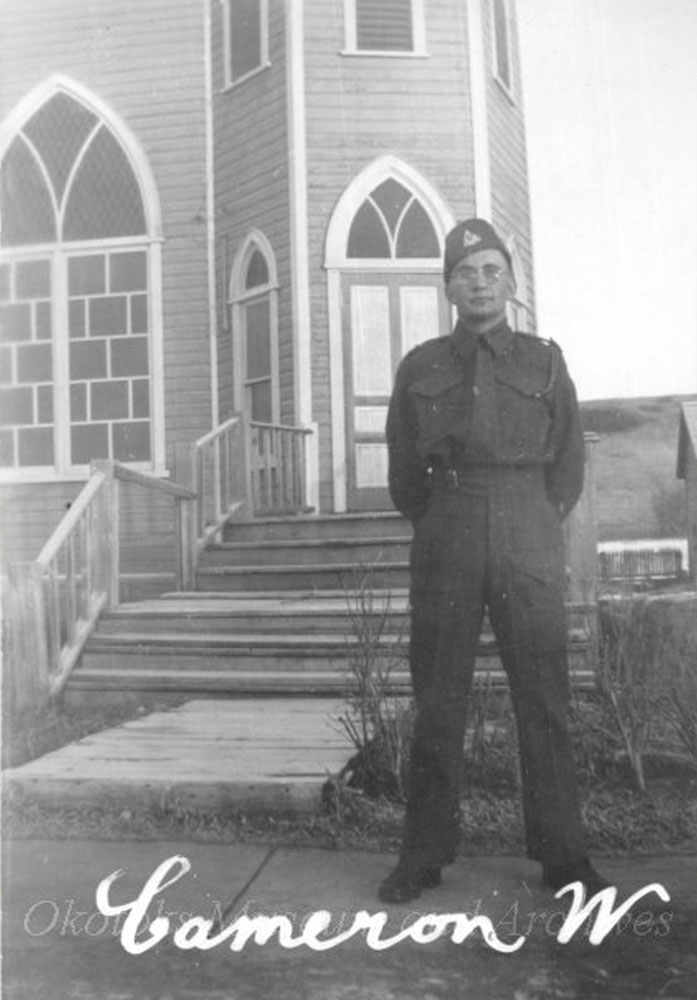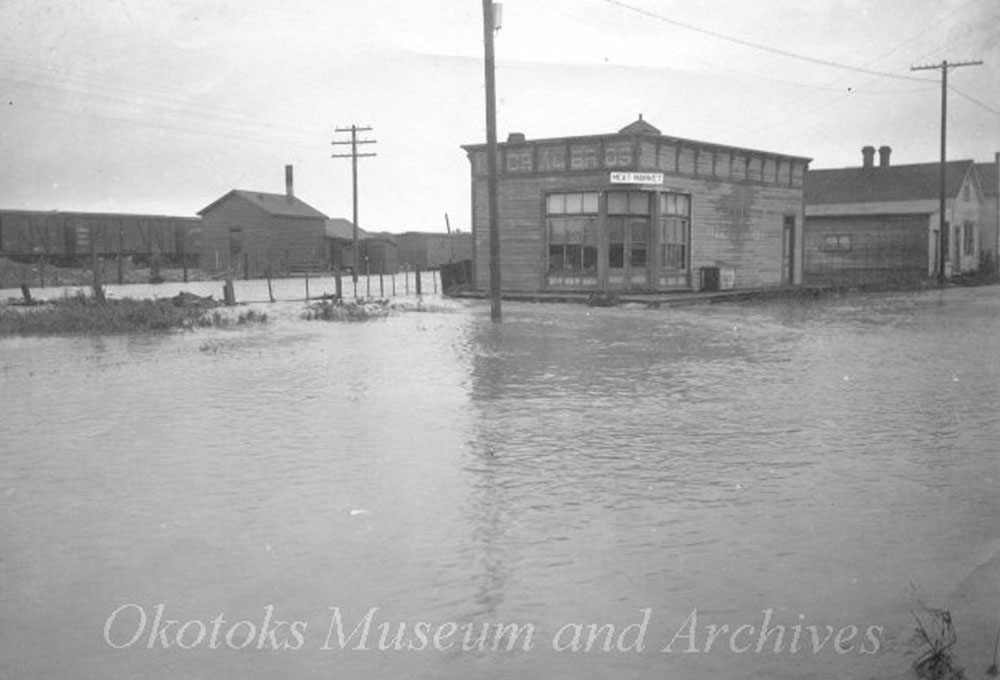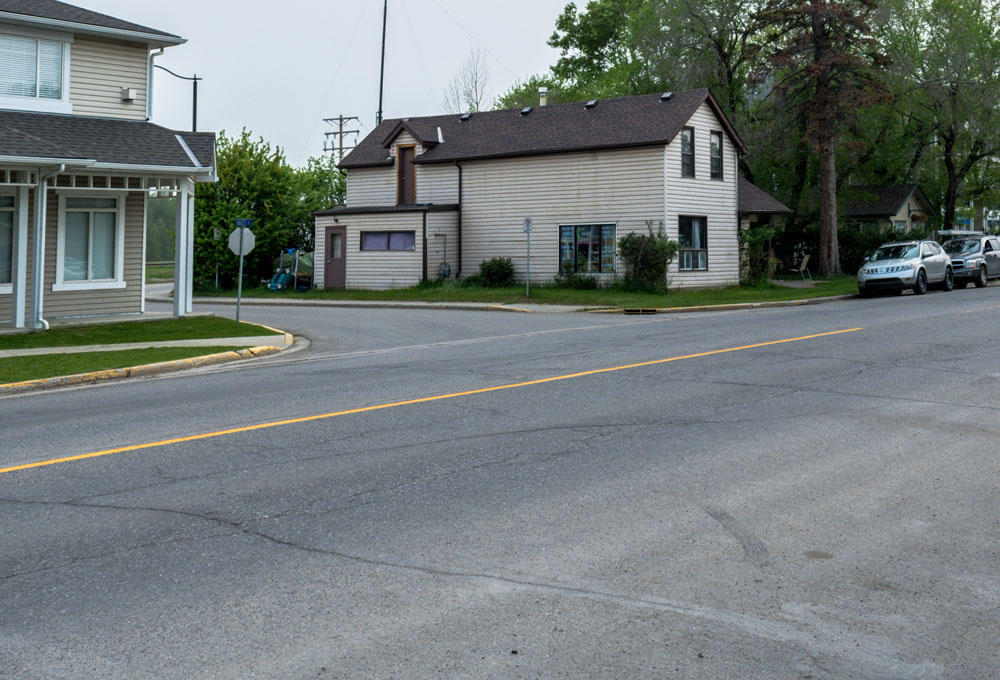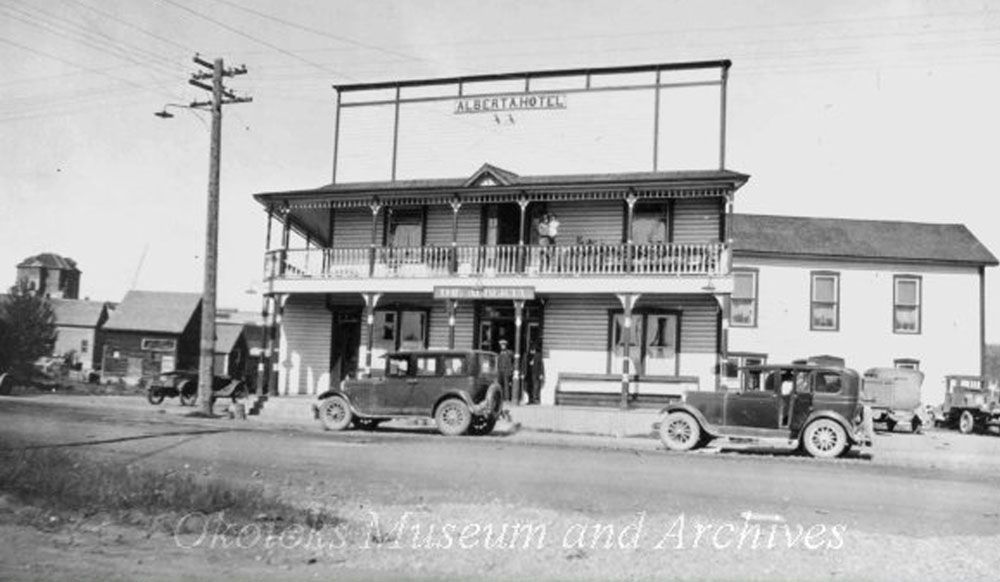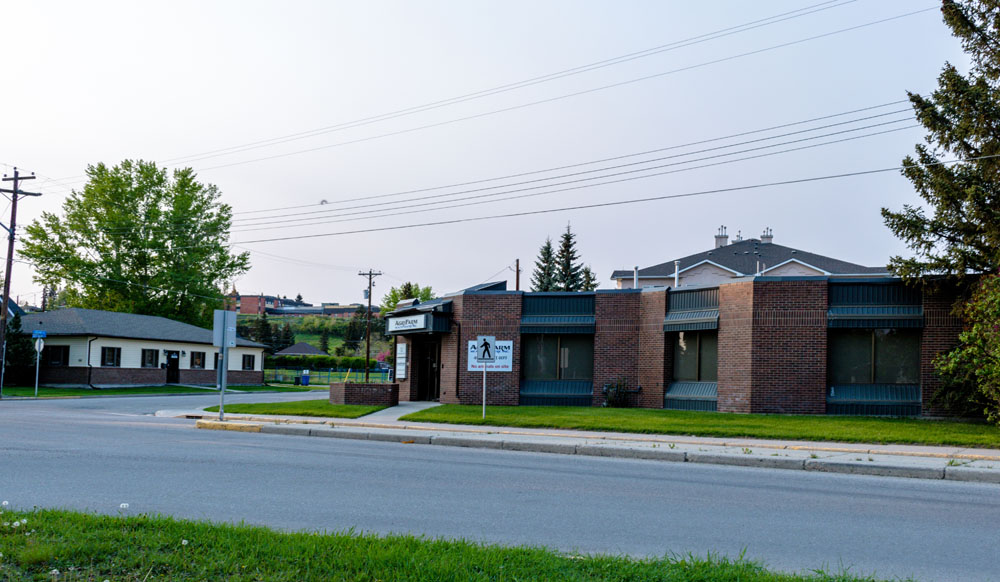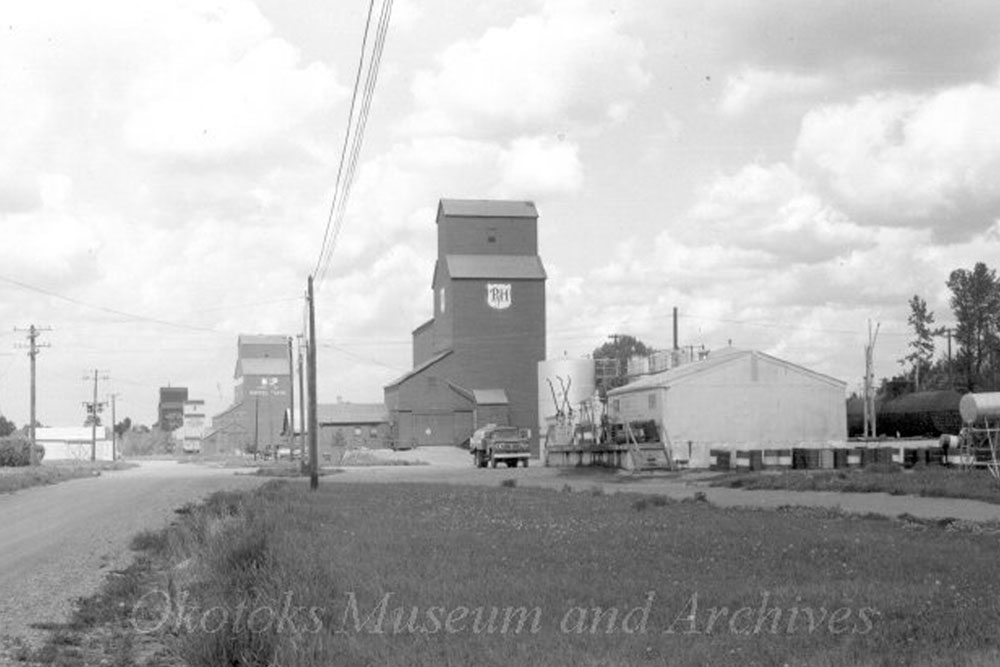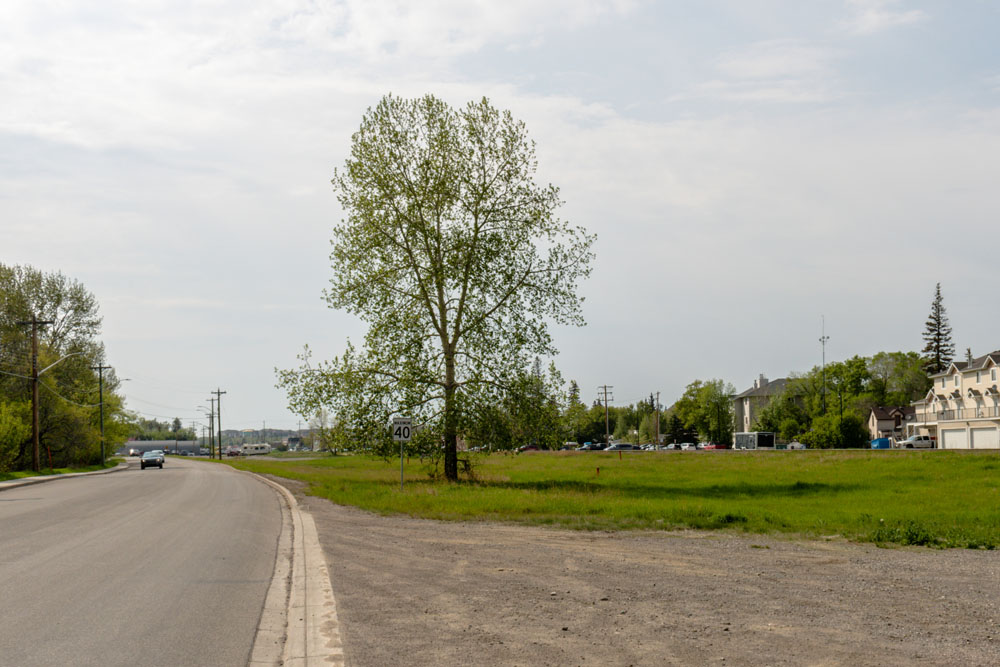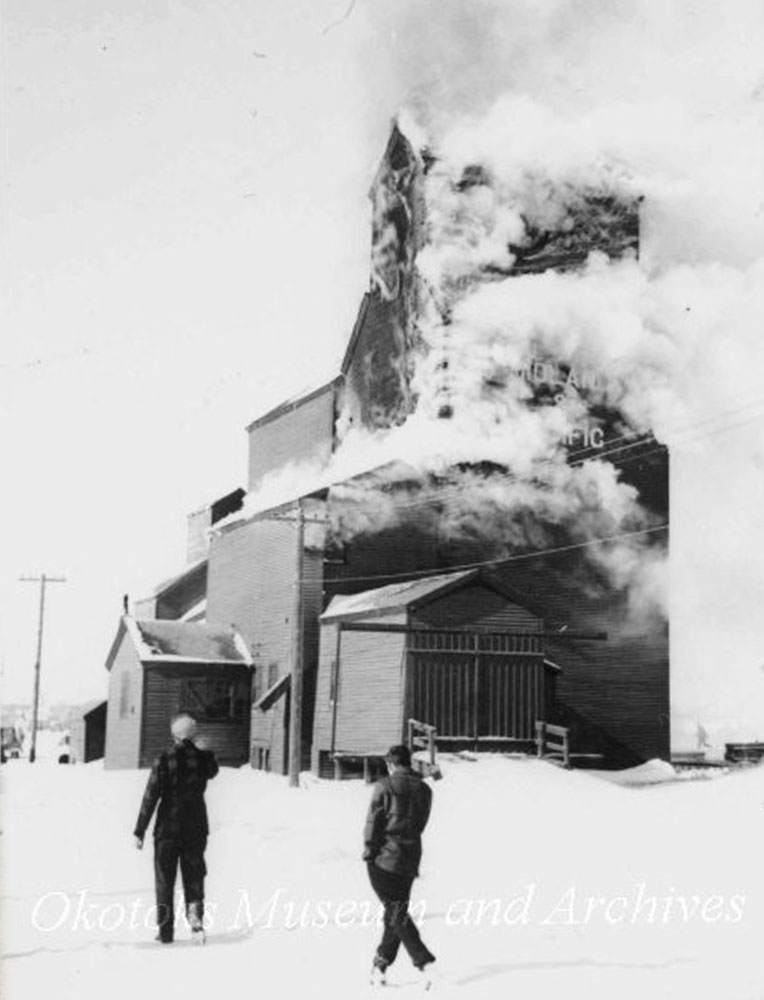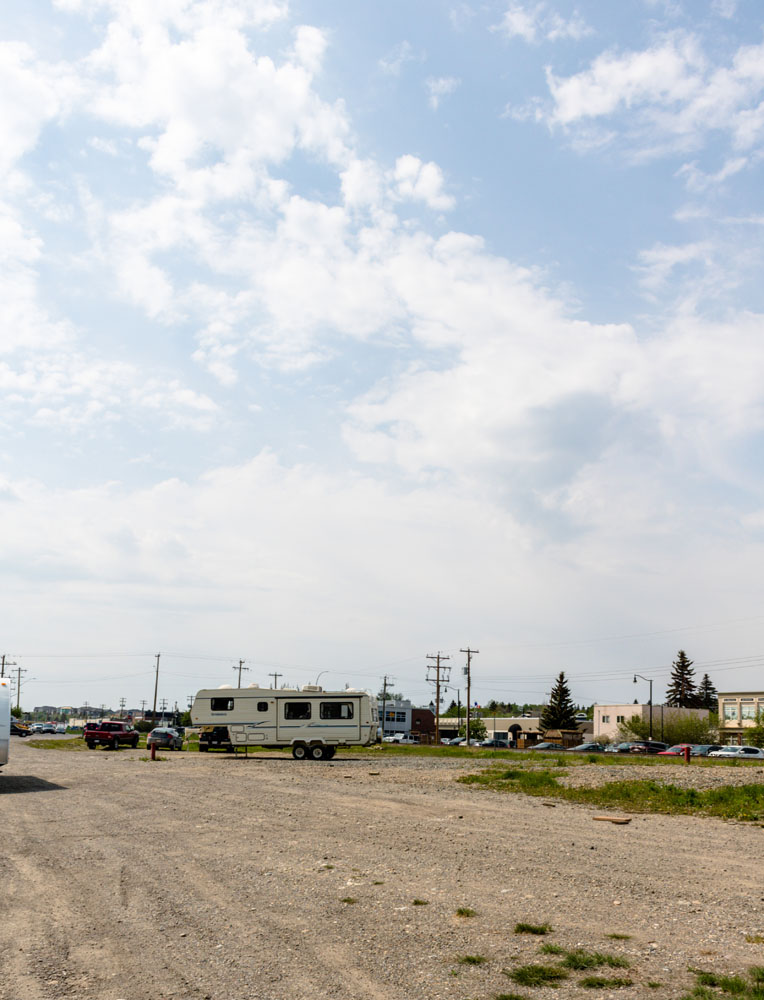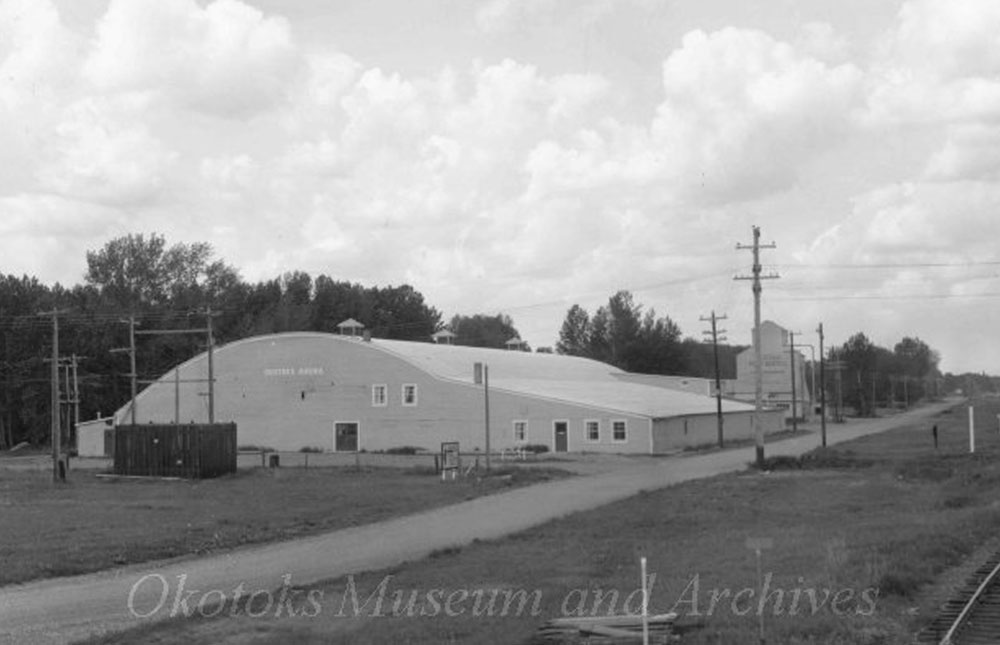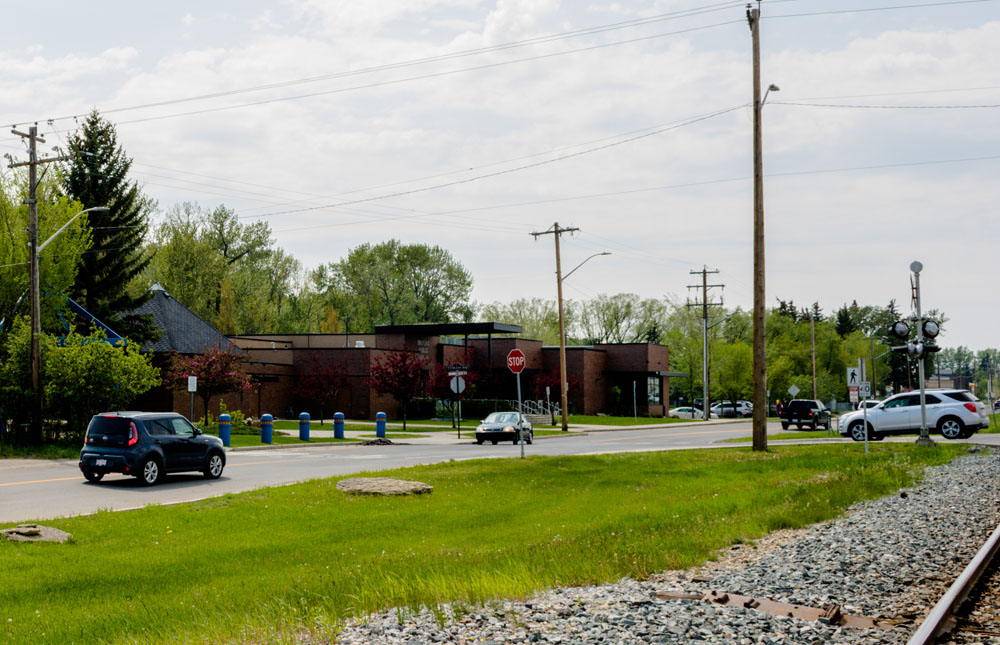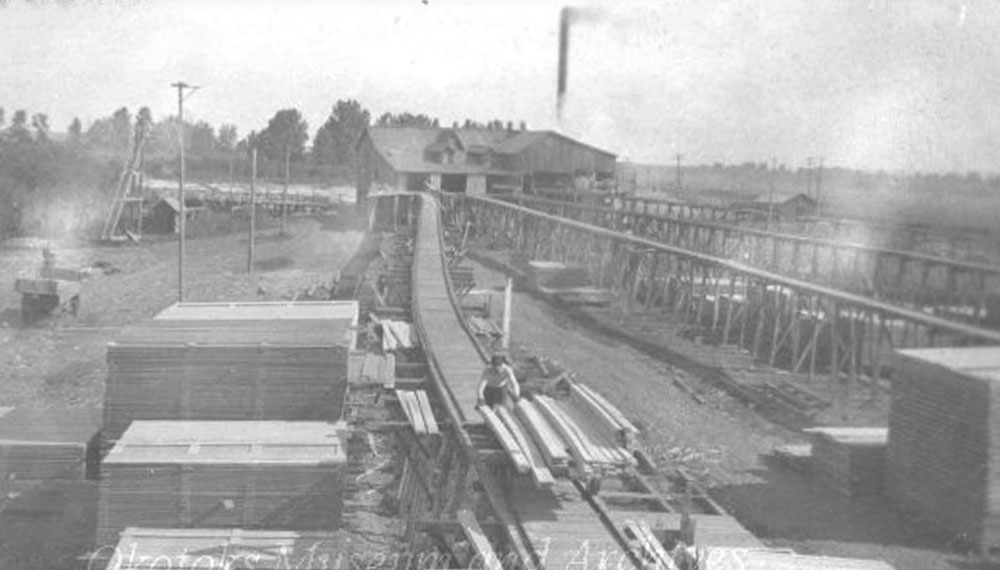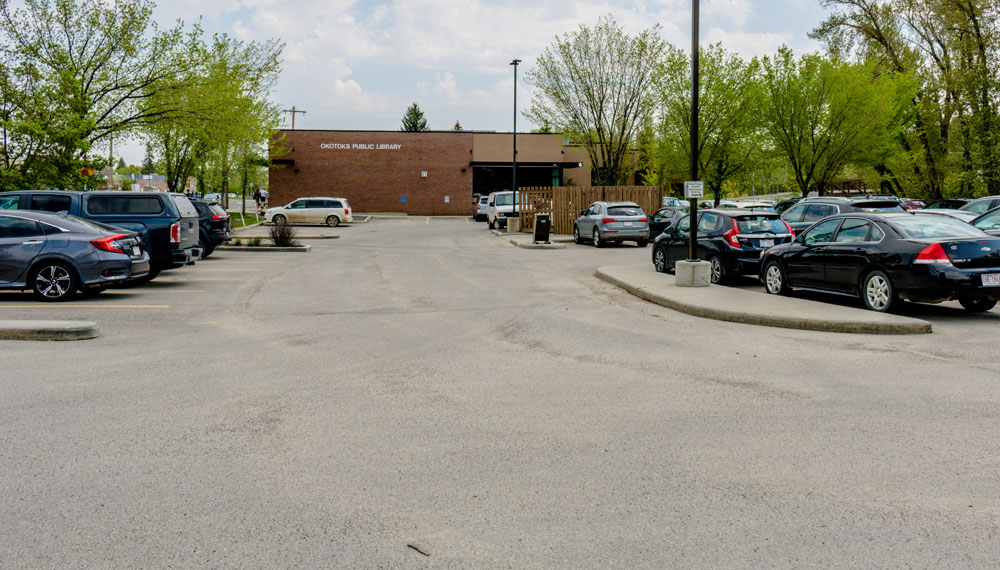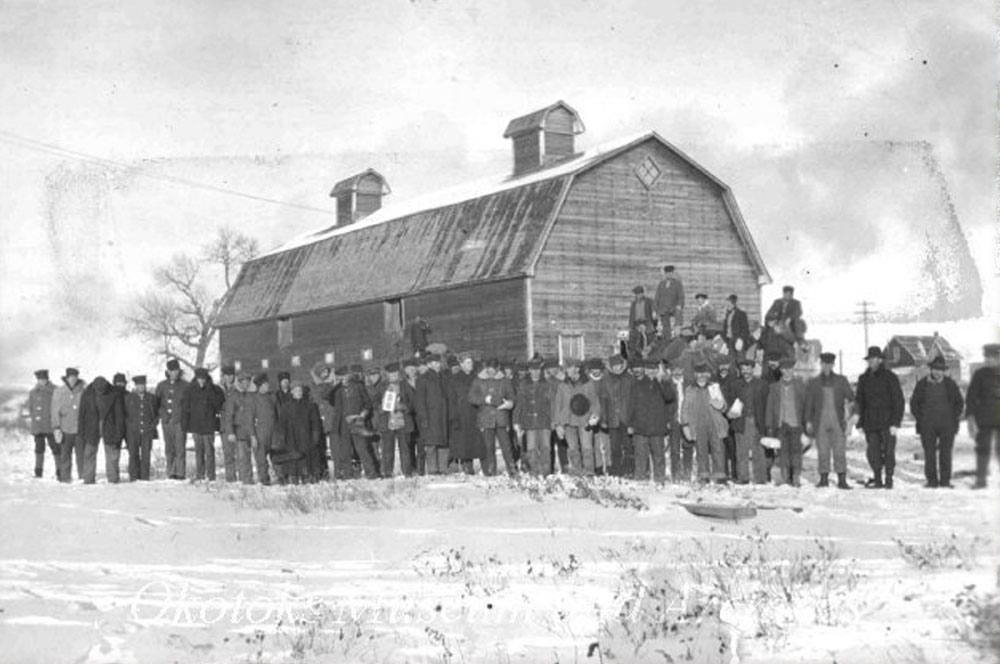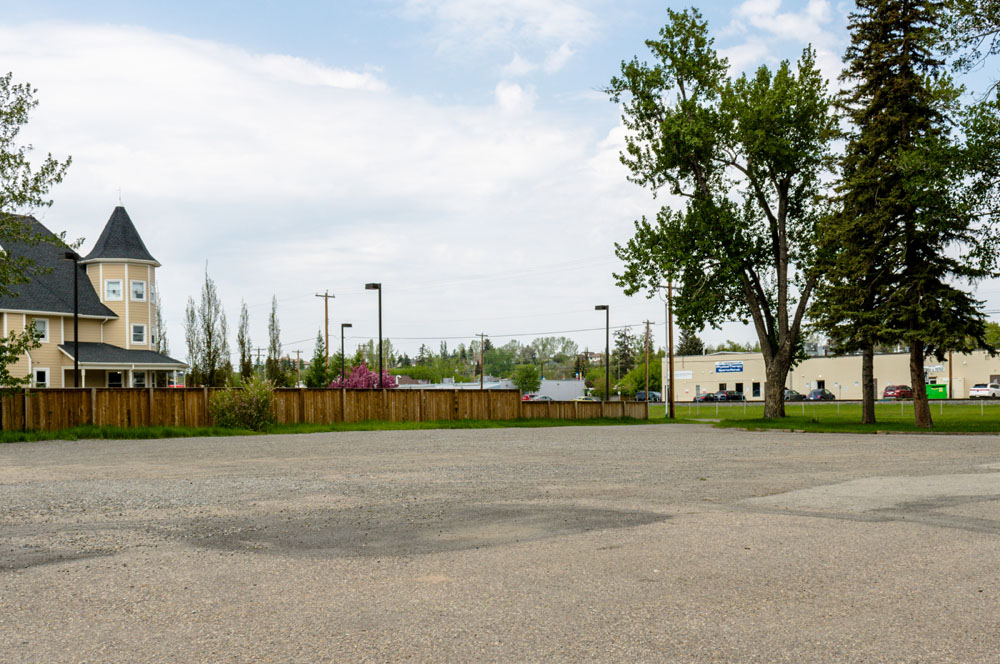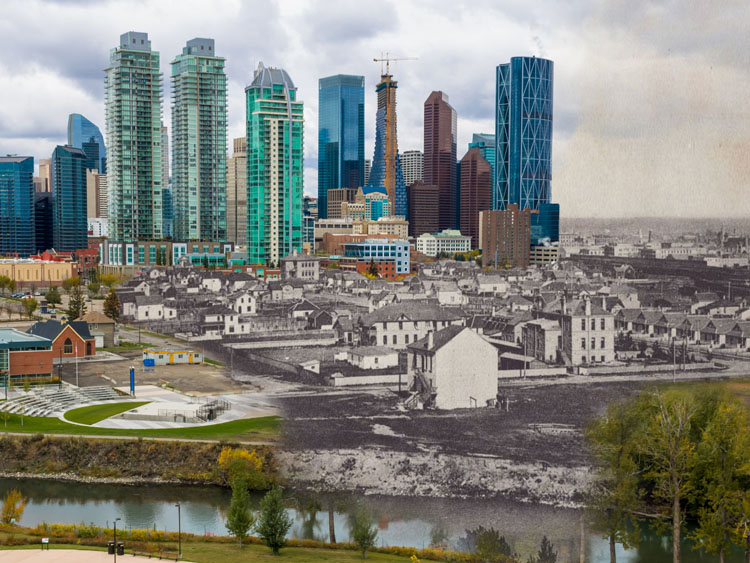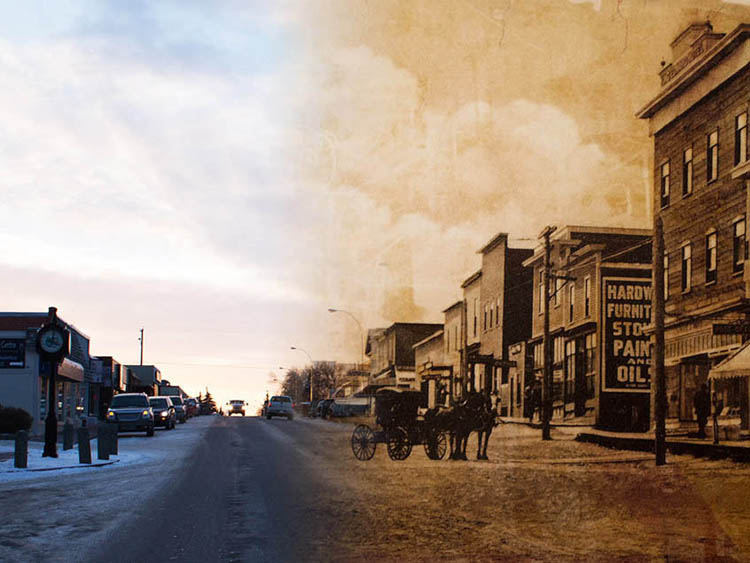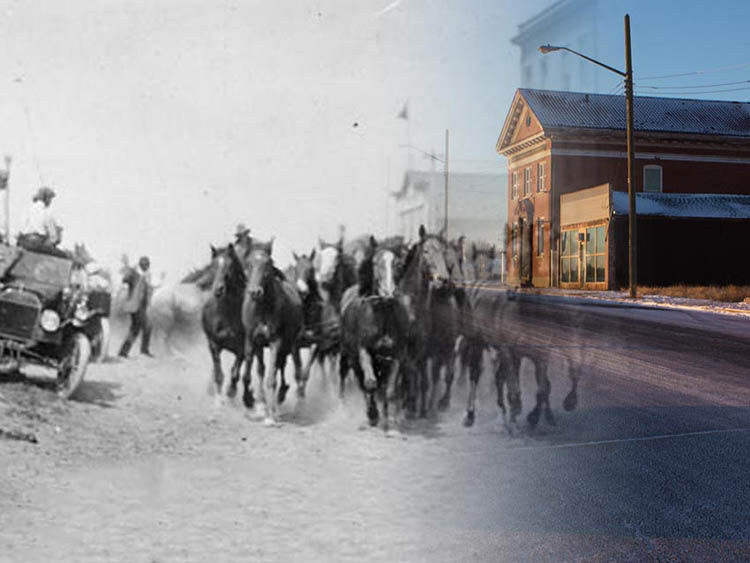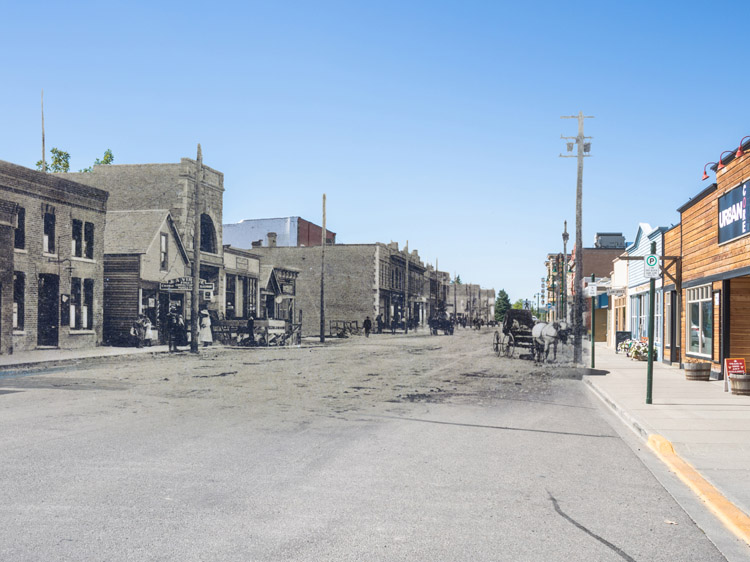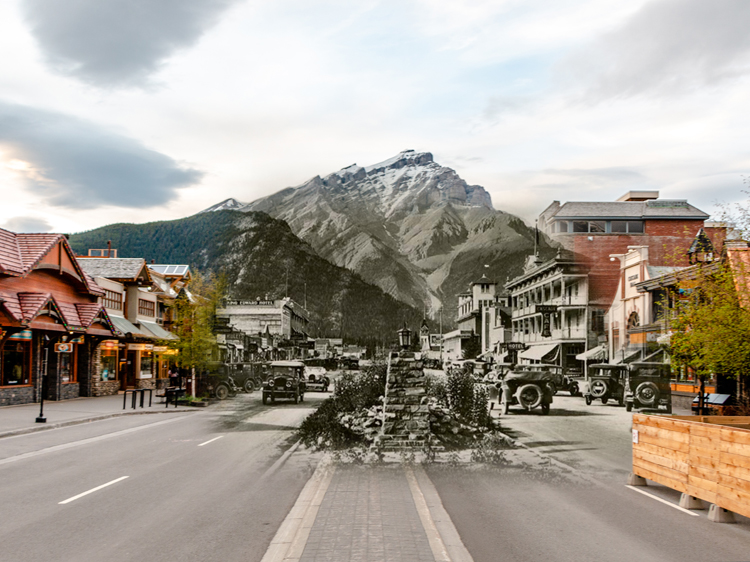Walking Tour
Vanished Okotoks
Places that have been Lost
Andrew Farris
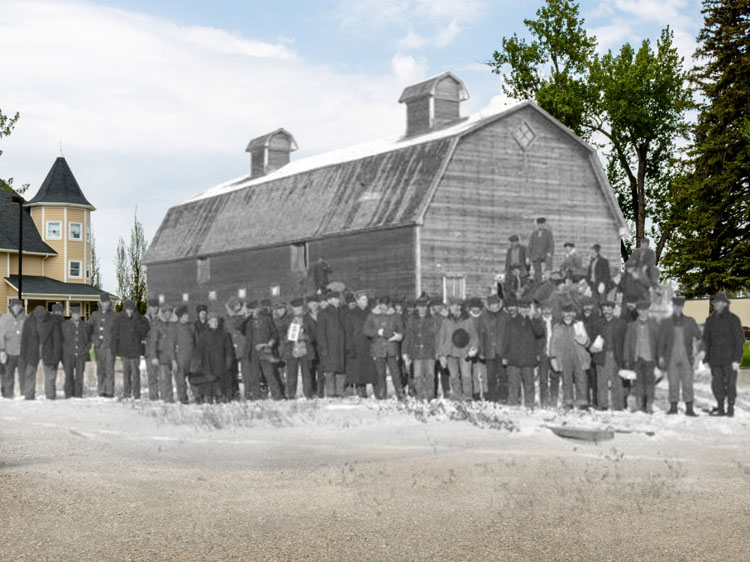
The face of Okotoks has changed many times since its incorporation as a village in 1893. Buildings that were once focal points of the community have vanished. Fires and floods, recessions and depressions, development and technological change, all have taken their toll on the buildings of Okotoks. When new buildings have risen to take their place, the memory of what was there before fades, but it is not lost. With the aid of historic photographs, we can reconjure these lost structures, and create a tangible connection with the past.
In this tour we will see some of the buildings that no longer stand, learn about the roles they fulfilled and meet the people who lived, worked, or played in them. We will see why some buildings survive, while others do not, and remind ourselves of the importance of preserving our heritage buildings whenever we can.
This tour begins near the former site of the Catholic Church on Northridge Drive, and continues down Elizabeth Street to see some of the homes and shops that once lined that thoroughfare. Then we'll continue down North Railway Street, the town's commercial core in its early years. Finally we'll loop back adjacent to the river, and learn how the lumber and agricultural industries contributed to Okotoks’ early economy.
This project is a partnership with the Okotoks & District Historical Society. We also would like to thank the Ridge at Okotoks for sponsoring our work trip.
1. St. James Catholic Church
1900s
This was the site of St. James Roman Catholic Church. It was built in 1903, making it the oldest Catholic church in the greater Calgary area. It was the centre of life in the small but vibrant Catholic community in St. James Parish that encompassed Okotoks and district.
* * *
On July 26, 1903, the new church was consecrated by Bishop Emile Legal of Saint- Albert (St. Albert). The ceremony was attended by 70 Catholics from the Okotoks area, but also 140 Protestants--much of the town turned out for the occasion. The first parish priest, Father Joseph Lestanc, as well as priests from elsewhere in the region attended. The prominent Father Albert Lacombe may have been there as well; an invitation to him for the blessing survives in the Provincial Archives, though it's unclear if he ever made the journey.2
The tightly-knit Catholic community was always a small minority in Okotoks, and this church served as its focal point. Parish records kept track of all the births, baptisms, marriages, and deaths amongst the flock.
This church fulfilled its purpose well for much of the 20th Century, since the local population didn't grow much beyond its early size around 500. Once the population began to grow in the 1970s, a new and larger church was needed. In 1983 a new St. James Church was built next to the original building and then in 2007 a new and even larger church was built on 32nd Street, giving worshippers in Okotoks a new home that they continue to use today.
2. The Toll of Floods
1915
Here we see a photo of major flooding sweeping over downtown Okotoks in 1915. The waters were high enough to cause the wooden sidewalks to begin floating away. The home in the back, belonging to Mrs. Scott, is clearly going to see some damage.
* * *
An account of the 1915 flood (pictured above), appeared in the Okotoks Review. It describes how the swelling river quickly overwhelmed the town, damaging many buildings in the process. It also tells how the community banding together to relieve the situation under intense pressure, and taking care of each other in the aftermath.
"Okotoks was visited by a bad flood last Saturday when our usually quiet and peaceable Sheep Creek went on the rampage in the early morning hours. The creek crossed the track and the little bridge at Spring Creek and poured down the roadway.
"Considerable relief was given to the situation by a number of volunteers in the early hours who cleared out the culverts under the C.P.R. tracks south of Hughes store. While they were doing this a large portion of the roadway under the track beside the culvert washed out and the water commenced to pour through and back to the creek. At its height the water was from 6 in. to 2 feet deep on Main Street and in the western portions of the town which are a little low the water was from three to five feet deep.
"The damage done was not nearly as great as was anticipated at first but the inconvenience to many was great. The families of C.O. Saunders, D. Morrison, Geo. Scott, Jack Thompson, Grindell, Rev. Rogers and several others had to flee in the middle of the night with water all around their houses.
"The water got into nearly all the cellars in town and the greatest amount of loss was done to the stock of the tenants of the Lineham Block... and also to the stock in the cellar of Ritchie & Allen's store at the corner. It is not certain yet what the total damage all over the town amounts to but probably a couple of thousand dollars would cover it.
"The worst inconvenience was caused by the bursting of the gas main where it crosses Sheep Creek close to the railway bridge. The company with commendable energy immediately got to work and by Sunday noon had a temporary connection made across the bridge. Those who had coal ranges were kept busy cooking for themselves and their neighbors.
"A relic of the flood is seen in the quantities of loose sidewalk floating around in the west end. The Council have put men to work however repairing and generally fixing things up, including the culvert beside the rink which was washed out…”1
3. The Daggetts
1915
The Daggett family and some of their friends pose for a photo on the veranda of their Okotoks home, which was once located at this spot. Ernest Daggett was one of the first foremen at the Lineham sawmill, and he and his family played an important role in the development of the town, which is evidenced by the street named after them running parallel to the railway tracks just south of here.
* * *
While it might seem these responsibilities would be enough for a young man, Ernest Daggett kept himself busy with all kinds of side projects. Daggett bought a 320 acre ranch near Davisburg and became an active member of the community there throughout the 1890s. Near the end of the decade he began a new homesteading ranch, near Blackie, Alberta, where he bred Clydesdales and raised Aberdeen Angus cattle.
Having saved up enough, he returned to New Brunswick in 1898 to marry Alberta Grace Watt, to whom he had been engaged for almost nine years. The newlyweds returned to Alberta the next year and bought a house in Okotoks (not this one). Ernest began working at the Lineham Lumber Company, supervising the mills at Okotoks and High River in the summer, and the logging camps up the Sheep River in winter. He quickly became well known in the town, not just for his work at the mill, but as an avid curler, and an elected member of the town council.
Mrs. Daggett stayed on at their ranch during the weekdays to maintain their homestead rights, and rode a horse and buggy to their Okotoks home on the weekends. The couple had their first and only child, Mary, in 1904. Mary was an enthusiastic horsewoman, and rode from their ranch to school every day. She would eventually attend the University of Alberta and become a teacher in the region.
Finally in 1909 the Daggetts built their new home in Okotoks, the one you see here. They also built a barn and shed on the property that housed a milk cow and horses for pulling buggies. They also bought a McLaughlin Buick, making them one of the first car owners in town.
"As in keeping with the pioneer spirit, the Daggett home was always open to everyone and many impromptu meals were served to visitors including Indian friends of the Blackfoot, Stoney, and Sacree Bands. Mrs. Daggett's mother, Mrs. Mary Watt lived with the Daggetts from 1912 until she died in 1921 at which time she was reputed to be Alberta's oldest resident at the age of ninety-nine. "Grandma Watt", although crippled with arthritis, knit many mittens and socks for the Red Cross during the World War I and for the needy in Okotoks."1
Ernest passed away in 1936, and his wife returned to New Brunswick, where she passed away in 1957. Their descendants continue to call Okotoks home.
4. McFarland Lumber Yard
1940-1942
Two children photographed on Elizabeth Street in the 1940s. Behind them is the McFarland Lumber Yard, a lumber retailer that primarily provided materials for industries like the growing oil business in nearby Turner Valley. Early on in Okotoks' development, some large warehouse wholesalers were located in the downtown core in addition to industries like the sawmill.
* * *
5. The Lineham Block
1936
Fire engulfs the Lineham Block in --- which once stood on this spot. Fortunately, nobody was killed in the fire, but the building, which resembled the surviving Stockton Block across the street, was never rebuilt. As local historian Karen Peters explained, “Because it was the Depression, only a couple of people went back into business but moved into other stores so those stayed empty for many, many years.”1
* * *
John Lineham's far-reaching impact in Okotoks, especially his sawmill, is covered in the other three walking tours in Okotoks, but we should also mention his interests in real estate. His first forays into property were in Calgary and actually predated the sawmill he established at Okotoks. They included the Leeson-Lineham Block on 8th Avenue in downtown Calgary, which was built in 1889 and survives to this day. Lineham went on to amass a small property empire on 8th Avenue that also included the Sharpies McLean Block and the Elma Block (named for his daughter).
The Lineham Block in Okotoks came a bit later, and was one of three imposing brick commercial blocks in early Okotoks, the others being the Stockton Block (which survives) and the McLeod Block (which also burned down).
As we can see, despite their sturdy construction, these buildings were still vulnerable to the elements. Twenty years before fire claimed this building, it also suffered heavy damage in a flood. The local newspaper described the effect that the disastrous 1915 flood had on the building:
"The water got into nearly all the cellars in town and the greatest amount of loss was done to the stock of the tenants of the Lineham Block, G.L. McCandless, A.Z. Hicks, McKay and Thompson and also to the stock in the cellar of Ritchie & Allen's store at the corner. It is not certain yet what the total damage all over the town amounts to but probably a couple of thousand dollars would cover it."3
6. Baptist Church
1940s
A photo of Wallace Cameron, who served with the Canadian Army during the Second World War. He's standing in front of the Baptist Church, which was built in 1902. While the building has survived and remains one of the town's oldest buildings, it has been heavily renovated and turned into the Heartland Cafe, a key fixture of the historic downtown.
* * *
Work began on the church right away, and it opened in 1902. In 1905 an organ was added too. However, despite the 91 identified Baptists in the community, only around 15 attended Sunday services, and the church had trouble raising money to pay a reverend's salary, making it difficult to keep a full-time minister in the town. Between 1908 and 1910 five different ministers cycled through the church, though finally Reverend Bracken was persuaded to stay on for a weekly salary of $8.65. Nevertheless as the town modernized so did the church, and in 1909 electric lighting was installed, and a gas furnace in 1915.
In the 1920s and 1930s ongoing financial problems were compounded by a congregation that shrank by almost two-thirds--only 36 people identified as Baptist in the census of 1931.3 In 1928 the church was left vacant, and would remain so until 1939 when it was purchased by Helmer Jacobson and rechristened the new Gospel Chapel, which eventually became the Evangelical Free Church. The major renovations that you can see, the removal of the bell tower and the remodelling of the front doors, occurred in 1988.
Finally in 1996 the Evangelical Free Church had outgrown this old building, and moved to its new location on Southridge Drive. This old church then became home to the Bowker & Scudds Garden Shop, then the Old Country Store, and finally in 2009, the Heartland Cafe.4
7. Ingram Bros. Meat Market
1912
Here we see the Ingram Brothers Meat Market during one of the many floods that wreaked havoc on Okotoks throughout its history. In the background you can see railway cars waiting at a siding. The building does not survive to the present, though it is unclear if it was this particular flood that led to the building's demolition. This photograph was taken by John Vanderpant, the Dutch photographer who occupied the McLeod Block and saw his photo studio consumed by flames during a fire in 1914 (a story we discuss in the Working in Okotoks tour).
* * *
Lillian Armstrong, daughter of one of the first farmers to arrive in Okotoks, recalls how butchers operated:
"In those days there were no government meat inspectors. When the butchers wanted some meat for their shops they contacted a farmer. The farmer or the butcher killed and "dressed" the meat, and took it to the meat market. They tanned the hides from the animals that they butchered and used some of these hides to put on the seats of the farm implements for warmth.
"In the early years the women canned much of their meat for use during the summer. During the winter they kept it frozen in a granary full of wheat. If there was a Chinook or a prolonged warm spell, the meat had to be canned. Before canning it Mom often roasted or fried some of the meat, or made small hamburger patties. Her canned chicken was a real delicacy in the summer. They cured pork by rubbing it with a special smoked salt and stored it in a brine in a large wooden barrel."2
Like many businesses, butchers and general stores often hired kids like 12-year-old Danny Evelyn to deliver meat to customers around the community.
During the Great Depression many farmers banded together to help feed each other. Annie Minue recalls how her parents were part of the 'Beef Ring.' Every Friday one of the farmers would slaughter a cow and get up early in the morning to cut and package it into sixteen shares, one for each member of the group.3
The Ingram Brothers Meat Market was only one of many butchers that have existed in Okotoks. Today, even after supermarkets have come to dominate Alberta communities, the people of Okotoks continue to be served by an array of speciality butchers.
8. The Alberta Hotel
1928
This photo shows the Alberta Hotel that once stood on this site, with several cars parked in front. This hotel was actually one of the oldest businesses in Okotoks, having been built in 1892 just after the arrival of the railway. The hotel was an important part of the town in its early days, providing lodging for newly arrived settlers as they got adjusted to the town, or seasonal workers who came to work on the farms, ranches, in the sawmill or on the railway.
* * *
There were two other hotels in the town's early years, including the Royal (which was located next door) and the Grand Central (which survives as the Royal Duke today on the corner of Elizabeth and Veterans Way).
9. Grain Elevators
1963
This open field was once home to five grain elevators, and elevator row, as it was known. Like almost every other town on the Canadian prairies, in the early 20th Century the tall wooden structures dominated the town's skyline and were a constant visual reminder of the central role of agriculture in the local economy. It's no surprise that elevators came to symbolize small town life on the Canadian prairies, and were an important part of Okotoks’ identity.
* * *
For the farmers, delivering grain at these elevators was the final step in a long, arduous process. Farming was endless, back-breaking labour. One Okotoks area farmer remembers that seeding a 1,000 acre farm required no less than 46 horses, as well as a huge crew of seasonal labourers.2 It was not made easier by the fact their yields were dependent on the weather. A hail storm, early frost, or prolonged drought could ruin an entire crop, and render months of effort wasted. Finally, the farmers would negotiate a price for their produce with the elevator company, who then sold the grain onto the global market.
Before World War II, the vast majority of farmers didn't have trucks to take their produce to competing neighbouring towns with other elevators operated by other companies, and had no option but to rely on the elevator company in the nearest town. This meant in many places elevator companies could establish local monopolies and effectively dictate grain prices paid to farmers. Even worse, many of these elevator companies were based far away in Eastern Canada, and their executives had little appreciation of the challenges faced by the prairie farmers, and they didn't hesitate to use their leverage to set arbitrarily low rates on the grain.
In the early 1900s the rates paid by elevator companies became one of the defining political issues in Alberta. Farmers banded together to form farmers’ cooperatives and lobbying organizations like the United Farmers of Alberta, which eventually became a political party that unexpectedly won a majority in Alberta's provincial election in 1921. The UFA government quickly established the Alberta Wheat Pool, which built its own elevators, seeking to break the monopoly of the eastern elevator companies.
Grain elevator politics represented the first bout of Alberta's alienation from Canada's industrial heartland in eastern Canada. It would not be the last.
10. End of the Elevators
1949
The Midland & Pacific grain elevator is engulfed by flames in 1949. The wooden grain elevators were highly vulnerable to fire, and most of the town's five grain elevators met their end in fire. The growing availability of trucks for transport meant the elevators quickly declined in importance, and those that burned down were not replaced, while others were deliberately demolished. It was the end of an era.
* * *
"When the P & H elevator burned late one cold night, consternation for the large Esso gas tanks exploding was indeed very real. The women and children bundled up in warm clothes and waited the long night to see if we were to be evacuated. Dad, along with every able-bodied man in town, fought the blaze with large hoses of water pouring on the tanks... To us as young children, this made a lasting impression."1
During the 1930s and 1940s agricultural technology evolved, as one Okotoks area farmer recalls:
"During the Hungry Thirties we farmed with horse-drawn equipment and threshing machines, then hauled the grain to the elevator with four or six horse teams hitched to grain tanks. However, as the years progressed, the tractor replaced horses, and combines replaced threshing machines. This eliminated the extra help during harvest time, and the women appreciated not having to cook for large threshing crews."2
By 1949, the same year the Midland & Pacific elevator burned down, Marie Indergaard remembered using a tractor and trailer to deliver grain to the National Elevator. "While the grain was being unloaded," she said, "I heard a gentleman say, "First time I ever saw a woman deliver grain to an elevator."3
The trucks and tractors meant farmers could go further afield to sell their grain to elevators, but it also meant fewer elevators were needed and they began to be consolidated into larger collection points. This was an important and decisive trend. In 1961 there were 1,642 so-called "country elevators" across Alberta, holding 3.5 million tonnes of grain. By 2010 this number had shrunk to merely 79, holding 1.6 million tonnes.4
The mighty elevators began to disappear from the Alberta townscape, and today work is under way to preserve those few that survive as heritage sites, since they were such an important part of each community's identity throughout the 20th Century. Unfortunately in Okotoks none of the elevators survived, and we are left only with the memories of the great buildings that once towered over this landscape.
11. The Skating Rink
1963
This central location in downtown Okotoks has seen multiple uses. First it was occupied by the Lineham Lumber Company sawmill (which we will come to at the next stop). Then from 1929 it was replaced by the skating arena you see in the historic photo. Finally, since 1990 it's been home to the Okotoks Public Library.
It's hardly surprising the arena occupied such an important spot in the middle of downtown Okotoks. Skating, hockey, and curling, were some of the most popular activities to keep people entertained through the long winter months.
* * *
"Hockey in those days was a far cry from what it is today. A good sturdy magazine filled in for padding on many occasions and helmets and masks were unheard of. Boys walked in to town from the country, or rode horseback, in 30° below weather."1
Okotokians excelled at hockey in those early years and won southern Alberta championships in 1909 and 1914. Many players went off to fight in the First World War, putting much hockey on hold in those years, and unfortunately the first arena burned down in 1918. Nevertheless, after the war Okotoks wanted to promote championship hockey, and invested in a new state-of-the-art arena to be built on the rubble of the old. Unfortunately, it wasn't as structurally sound as hoped, and in 1925 it collapsed under the weight of snow on the roof.
As the Turner Valley oilfield boomed in 1927, Imperial Oil and Royalite Oil sponsored a new senior team, the Okotoks-Turner Valley Imperials, bringing in players from all over Alberta and giving them oilfield jobs. They also helped fund the building of a new and even better arena in 1929--the one you see here.
From 1930-32 the Imperials played to a crowd of thrilled crowd of 1,400, larger than the population of the town itself at the time. Unfortunately these exciting times were to be shortlived, and the Great Depression led to the disbanding of the senior team in 1931. When the economy had recovered by 1938, the team was reconstituted as the Turner Valley/Okotoks Oilers. "This proved to be one of the great all-time amateur clubs of Alberta continuing to play to packed rinks," write the historians.2
Unfortunately this new surge of hockey interest was again to be short-lived, as "a great many star players left to join the armed forces during the Second Great War. At the end of 1941 the team disbanded and the hockey in Okotoks was low profile until the war ended in 1945."3
When hockey picked up again, there would be no more interruptions. The game has remained a key part of culture in Okotoks to this day, though the arena itself was torn down in the 1980s. Fortunately it was replaced, and Okotoks now boasts three arenas spread across town.
12. The Sawmill
1910
Looking out over today's library parking lot, we can see the tramways leading to the Lineham Sawmill that once stood roughly on this spot. The sawmill played a crucial role in the establishment of Okotoks, which is discussed at length in the Working in Okotoks and Sheep River tours.
13. The Horse Barn
1910-1916
A work crew from the lumber yard stands in front of the horse barn used by the Lineham Lumber Company. Built in 1897, the barn was considered to be one of the oldest buildings in town and the last surviving part of the sawmill that played such an important role in the town's history. Unfortunately it was torn down in 2015 after fire destroyed the building beyond repair.
* * *
The Okotoks Creamery became a vital industry in the community. Local farmers could sell their milk and cream to the creamery where it was processed into butter. Neil Dorsey operated the creamery for 20 years and received many awards for the best grade butter in Canada. In 1947 they sold the Creamery to their employee, Ernest Dawson, In 1955, Ernest sold it to his employee, Clarence Otterbein, who continued to operate it with his wife Vera until 1969.
The building went on to serve as a teen centre, lumberyard, restaurant and the Bull Pen Pub. The town bought the lot in 2014, but a year later fire partially damaged the building and it was demolished.
Endnotes
1. St. James Catholic Church
1. "Parish History," St. James Parish Okotoks, online.
2. Okotoks and District Historical Society, A Century of Memories: Okotoks and District, 1883-1983 (Okotoks: Okotoks and District Historical Society, 1983), 25.
2. The Toll of Floods
1. Okotoks and District Historical Society, 63.
3. The Daggetts
1. Okotoks and District Historical Society, 186.
5. The Lineham Block
1. Tammy Rollie, "Walking tour a blast from the past," Okotoks Today, online.
2. Krista Conrad, "Pioneering forefather built foundation of Okotoks," Okotoks Today, Feb. 21, 2018, online.
3. Okotoks and District Historical Society, 63.
6. Baptist Church
1. Thomas, 15.
2. Okotoks and District Historical Society, 20.
3. Thomas, 15.
4. "History", Heartland Cafe, online.
7. Ingram Bros. Meat Market
1. Okotoks and District Historical Society, 279.
2. Okotoks and District Historical Society, 297.
3. Okotoks and District Historical Society, 431.
9. Grain Elevators
1. Okotoks and District Historical Society, 137.
2. Okotoks and District Historical Society, 116.
10. End of the Elevators
1. Okotoks & District Historical Society, 116.
2. Okotoks & District Historical Society, 172.
3. Okotoks & District Historical Society, 317.
4. "Grain Elevators," Wikipedia, online.
11. The Skating Rink
1. Okotoks and District Historical Society, 685.
2. Okotoks and District Historical Society, 687.
3. Okotoks and District Historical Society, 688.
Bibliography
Conrad, Krista. "Pioneering forefather built foundation of Okotoks." Okotoks Today. Feb. 21, 2018. https://www.okotokstoday.ca/local-news/walking-tour-a-blast-from-the-past-1536219
"Grain Elevators," Wikipedia. https://en.wikipedia.org/wiki/Grain_elevator.
"History", Heartland Cafe. https://www.heartlandcafe.ca/history
Okotoks and District Historical Society. A Century of Memories: Okotoks and District, 1883-1983. Okotoks: Okotoks and District Historical Society, 1983.
"Parish History," St. James Parish Okotoks. https://stjamesparishokotoks.ca/church-history
Rollie, Tammy. "Walking tour a blast from the past." Okotoks Today. July 4, 2018.





